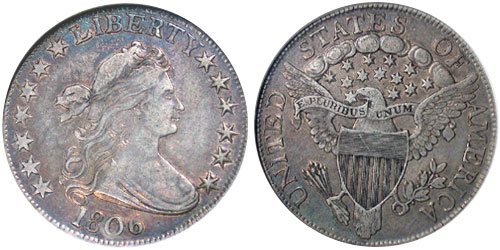Guide to U.S. Draped Bust Half Dollars
The Draped Bust Half Dollar represented the second series for the half dollar denomination. The coins were produced with two different reverse designs, creating two distinct subtypes. The first subtype with a small eagle on the reverse was struck from 1796 to 1797. The extremely limited mintage across the two years of production makes this the rarest silver type within American numismatics. The second subtype with a heraldic eagle on the reverse was struck from 1801 to 1807. With a larger range of dates and higher mintages, this subtype is generally more available, although uncirculated specimens and certain varieties remain rare.

The objective of the early United States Mint was not only to produce an adequate supply of copper, silver, and gold coinage, but also to make the coins more or less uniform in appearance. As such, designs were largely similar across the various denominations and design changes took place within similar timeframes. The Draped Bust design created by Robert Scot, the first Chief Engraver of the United States Mint, was introduced in 1796. The design was based on the work of portraitist Gilbert Stuart, who had supposedly used Philadelphia resident Anne Willing Bingham as a model for Liberty.
The obverse features the head of Liberty, facing right. The partially visible bust is draped, hence the name given to this design in the 19th century, which continues to be used today. The word LIBERTY appears above, and the date appears below. An arrangement of stars appears to each side of Liberty. The half dollars issued in 1796 had either fifteen or sixteen stars in total. The additional star was added after Tennessee became the sixteenth state of the Union in June 1796. Interestingly, the 1797 half dollars once again featured only fifteen stars, followed by a gap in production. When the denomination resumed in 1801, only thirteen stars were used to represent the original thirteen states in the Union.
From 1796 to 1797 the series would use “small eagle” reverse design, which had carried over in use from the previous series. The design features a bald eagle standing on a bank of clouds, encircled by a wreath slightly open at the top and bound by a ribbon at the bottom. The words UNITED STATES OF AMERICA appear surrounding. The fraction “1/2” appears at the base to indicate the value of the coin, which is further indicated with edge lettering reading FIFTY CENTS OR HALF A DOLLAR.
After two years of issue, the series would see a three-year gap in production. During this time, a new reverse design had been introduced for the other silver denominations. The so-called “heraldic eagle” reverse design would be adopted for the half dollar as well. Base on the Great Seal of the United States, an eagle appears at center with its wings spread with a shield at its breast. Its talons grasp an olive branch and bundle of arrows, while its beak holds a ribbon bearing the motto E PLURIBUS UNUM. An arc of clouds above encloses thirteen stars. The words UNITED STATES OF AMERICA surround the image, with the denomination now indicated only on the edge of the coin. This reverse design would be used from 1801 until the conclusion of the series in 1807.

